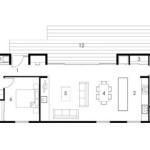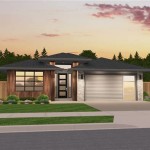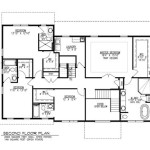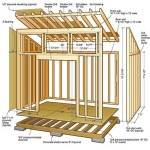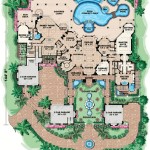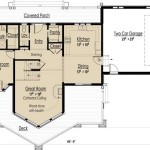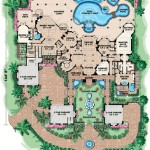House floor plans design refers to the arrangement and organization of rooms and spaces within a house. It involves the creation of blueprints and diagrams that outline the layout, dimensions, and relationships between different areas of the home. Floor plans are essential for visualizing the overall structure and functionality of a house, ensuring that the design is practical, efficient, and meets the specific needs and preferences of the occupants.
For instance, in the design of a three-bedroom house, the floor plan may include a main living area with a living room, kitchen, and dining space, connected to three separate bedrooms, each with its own closet and bathroom. By carefully considering the placement and size of each room, the floor plan can create a comfortable and functional living environment that meets the occupants’ daily routines and lifestyle.
In the following sections, we will delve deeper into the various aspects of house floor plans design, exploring different types of floor plans, design considerations, and technological advancements that are transforming the way homes are designed and built.
When designing the floor plan of a house, there are several key points to consider to ensure functionality, efficiency, and aesthetic appeal.
- Space planning
- Traffic flow
- Natural lighting
- Room size and proportions
- Storage and built-ins
- Outdoor connections
- Flexibility and adaptability
- Energy efficiency
- Building codes and regulations
By carefully considering these factors, architects and designers can create floor plans that meet the specific needs and preferences of the occupants, while also ensuring that the house is safe, comfortable, and enjoyable to live in.
Space planning
Space planning is a crucial aspect of house floor plans design, involving the arrangement and organization of rooms and spaces within the home to create a functional, efficient, and aesthetically pleasing living environment. It encompasses the allocation of space for different activities and functions, ensuring that each room has the appropriate size and proportions to accommodate furniture, circulation, and storage.
Effective space planning considers the relationship between different rooms and how they are used. For example, the kitchen should be conveniently located near the dining area and pantry, while the living room should be easily accessible from the main entrance and offer comfortable seating arrangements. By carefully considering the flow of movement and interaction between different spaces, space planning can create a home that is easy to navigate and use.
Another important aspect of space planning is the efficient use of available space. This involves designing rooms and storage areas that are neither too large nor too small for their intended purpose. By maximizing space utilization, space planning can minimize wasted space and create a more compact and efficient home.
Finally, space planning should also consider the overall aesthetic appeal of the home. The arrangement of rooms and the flow of space should create a visually pleasing and harmonious environment. This can be achieved through the use of balanced proportions, natural lighting, and well-defined spaces.
Overall, space planning is a complex and challenging task that requires careful consideration of multiple factors. By following the principles of functionality, efficiency, and aesthetics, architects and designers can create house floor plans that meet the specific needs and preferences of the occupants, while also ensuring that the home is a comfortable and enjoyable place to live.
Traffic flow
Traffic flow refers to the movement of people and objects through a space. In house floor plans design, traffic flow is an important consideration to ensure that the home is easy and safe to navigate, and that there is minimal disruption to daily activities.
Good traffic flow involves creating a clear and efficient path between different areas of the home. This can be achieved by avoiding bottlenecks and creating wide, open spaces that allow for easy movement. For example, the main entrance should lead directly into a spacious foyer or hallway that provides access to the different rooms of the house. Similarly, the kitchen should be designed with ample space for multiple people to move around and work efficiently.
Another important aspect of traffic flow is the separation of public and private spaces. Public spaces, such as the living room and dining room, should be easily accessible from the main entrance and should allow for easy flow of guests. Private spaces, such as bedrooms and bathrooms, should be located away from public areas to ensure privacy and tranquility.
Finally, traffic flow should also consider the circulation of natural light and air. By placing windows and doors strategically, architects and designers can create a home that is naturally lit and ventilated, reducing the need for artificial lighting and improving overall comfort.
Overall, traffic flow is a crucial aspect of house floor plans design that can significantly impact the functionality and livability of a home. By carefully considering the movement of people and objects through the space, architects and designers can create homes that are easy to navigate, safe, and enjoyable to live in.
Natural lighting
Natural lighting refers to the use of sunlight to illuminate interior spaces. In house floor plans design, natural lighting is an important consideration to ensure that homes are bright, airy, and energy-efficient.
There are several benefits to incorporating natural lighting into house floor plans. First, natural light can help to reduce energy consumption by reducing the need for artificial lighting. This can lead to significant savings on energy bills over time.
Second, natural light can improve the overall mood and well-being of occupants. Studies have shown that exposure to natural light can boost serotonin levels, which can lead to increased feelings of happiness and well-being. Additionally, natural light can help to regulate the body’s circadian rhythm, which is important for sleep and overall health.
Third, natural light can create a more visually appealing and comfortable living environment. Natural light can help to make rooms appear larger and more spacious, and it can also highlight architectural features and create a more inviting atmosphere.
To incorporate natural lighting into house floor plans, architects and designers can use a variety of strategies. One common strategy is to place windows and doors strategically to allow for maximum sunlight exposure. Windows should be placed on the south side of the house in the Northern Hemisphere, and on the north side of the house in the Southern Hemisphere, as these orientations receive the most sunlight throughout the day.
Room size and proportions
Room size and proportions refer to the dimensions and shape of a room, and how they relate to the overall design of the house. Getting the room size and proportions right is essential to creating a home that is both functional and aesthetically pleasing.
There are several factors to consider when determining the size and proportions of a room. One important factor is the function of the room. For example, a living room should be large enough to accommodate furniture and seating for guests, while a bedroom should be large enough to fit a bed, dresser, and other furniture. Another factor to consider is the relationship between the room and other spaces in the house. For example, the kitchen should be located near the dining room, and the master bedroom should be located away from public areas of the house.
In addition to the function and relationship of the room, the overall aesthetic of the house should also be considered when determining the room size and proportions. For example, a large, open floor plan can create a more spacious and modern feel, while a house with smaller, more defined rooms can create a more traditional or cozy feel.
Finally, the room size and proportions should also comply with building codes and regulations. These codes and regulations may specify minimum and maximum room sizes, as well as requirements for ceiling heights and window sizes.
Overall, determining the room size and proportions is a complex and challenging task that requires careful consideration of multiple factors. By following the principles of functionality, aesthetics, and building codes, architects and designers can create homes that are both beautiful and livable.
Storage and built-ins
Storage and built-ins are essential components of house floor plans design, providing convenient and space-saving solutions for organizing belongings and maximizing the functionality of a home.
Built-in storage can take many forms, such as closets, cabinets, shelves, drawers, and pantries. These built-ins can be incorporated into walls, under stairs, or in other unused spaces, providing ample storage without taking up valuable floor space. By carefully planning the placement and design of built-ins, architects and designers can create homes that are both organized and clutter-free.
In addition to providing storage, built-ins can also enhance the aesthetic appeal of a home. Custom-designed built-ins can be tailored to match the style and dcor of the home, creating a cohesive and polished look. For example, built-in bookshelves can be designed to complement the architectural features of a room, while built-in window seats can provide a cozy and inviting spot to relax.
Another advantage of built-ins is that they can increase the value of a home. Potential buyers often look for homes with ample storage space, and built-ins can provide a significant advantage over homes that lack adequate storage.
Overall, storage and built-ins are an essential part of house floor plans design, providing both functional and aesthetic benefits. By carefully considering the storage needs of the occupants and the overall design of the home, architects and designers can create homes that are both organized and beautiful.
Outdoor connections
Outdoor connections refer to the ways in which a house is connected to its surrounding outdoor environment. This can include features such as patios, decks, balconies, and porches, as well as the overall orientation of the house on the lot.
Outdoor connections are an important consideration in house floor plans design for several reasons. First, they can provide a seamless transition between indoor and outdoor spaces, creating a more spacious and inviting living environment. Outdoor connections can also provide opportunities for natural light and ventilation, which can improve the overall health and well-being of occupants.
In addition, outdoor connections can increase the value of a home. Potential buyers often look for homes with outdoor living spaces, as they provide a place to relax, entertain, and enjoy the outdoors.
There are several different ways to create outdoor connections in house floor plans design. One common strategy is to use large windows and doors that open up to patios, decks, or balconies. Another strategy is to design the house around a central courtyard or atrium, which can provide natural light and ventilation to interior spaces.
When designing outdoor connections, it is important to consider the climate and local environment. In hot climates, it is important to provide shade and protection from the sun. In cold climates, it is important to provide windbreaks and protection from the elements.
Flexibility and adaptability
Flexibility and adaptability refer to the ability of a house floor plan to accommodate changing needs and lifestyles over time. This can be achieved through the use of movable walls, partitions, and other design elements that allow for easy reconfiguration of the space.
There are several benefits to designing a flexible and adaptable house floor plan. First, it can allow occupants to change the layout of their home to suit their changing needs. For example, a family with young children may want to create a more open floor plan to accommodate play areas, while an empty nester couple may want to create a more private and secluded master suite.
Another benefit of flexibility and adaptability is that it can help to future-proof a home. As technology and lifestyles change, the need for new and different spaces may arise. A flexible floor plan can accommodate these changes without the need for major renovations.
Finally, flexibility and adaptability can also increase the value of a home. Potential buyers often look for homes that can be easily adapted to their own needs and preferences. A flexible floor plan can give buyers the confidence that they can make changes to the home in the future without having to spend a lot of money on renovations.
There are several different ways to design a flexible and adaptable house floor plan. One common strategy is to use movable walls and partitions. These walls and partitions can be easily moved or removed to create different room configurations. Another strategy is to use multi-purpose spaces that can be used for a variety of activities. For example, a dining room could also be used as a home office or playroom.
Energy efficiency
Energy efficiency refers to the ability of a house to use energy wisely, reducing energy consumption and saving money on utility bills. There are several ways to incorporate energy efficiency into house floor plans design, including:
- Orientation: The orientation of the house on the lot can have a significant impact on its energy efficiency. In the Northern Hemisphere, houses that are oriented to the south receive more sunlight, which can help to reduce heating costs in the winter. In the Southern Hemisphere, houses that are oriented to the north receive more sunlight, which can help to reduce cooling costs in the summer.
- Insulation: Insulation is one of the most important factors in determining the energy efficiency of a house. Good insulation helps to keep the house warm in the winter and cool in the summer, reducing the need for heating and cooling. Insulation can be installed in the walls, ceiling, and floor of the house.
- Windows and doors: Windows and doors are another important factor in determining the energy efficiency of a house. Energy-efficient windows and doors are designed to minimize heat loss and gain, helping to keep the house more comfortable and reduce energy consumption.
- Appliances: The appliances in a house can also have a significant impact on its energy efficiency. Energy-efficient appliances are designed to use less energy, saving money on utility bills and reducing the environmental impact of the home.
By incorporating energy efficiency into house floor plans design, architects and designers can create homes that are more comfortable, affordable, and sustainable.
Building codes and regulations
Building codes and regulations are a set of rules and standards that govern the design and construction of buildings. These codes and regulations are in place to ensure that buildings are safe, habitable, and energy-efficient.
When designing a house floor plan, it is important to comply with all applicable building codes and regulations. These codes and regulations may vary from place to place, so it is important to check with the local building department to determine which codes and regulations apply in your area.
Some of the most common building codes and regulations that apply to house floor plans design include:
- Minimum room sizes: Building codes typically specify minimum room sizes for different types of rooms, such as bedrooms, kitchens, and bathrooms. These minimum room sizes are in place to ensure that rooms are large enough to be habitable and to provide adequate space for furniture and movement.
- Ceiling heights: Building codes also typically specify minimum ceiling heights for different types of rooms. These minimum ceiling heights are in place to ensure that rooms are tall enough to be comfortable and to provide adequate ventilation.
- Window sizes: Building codes may also specify minimum window sizes for different types of rooms. These minimum window sizes are in place to ensure that rooms have adequate natural light and ventilation.
- Energy efficiency: Building codes may also include energy efficiency requirements for new homes. These requirements may specify minimum levels of insulation, energy-efficient appliances, and other features that can help to reduce energy consumption.
By complying with all applicable building codes and regulations, architects and designers can ensure that their house floor plans are safe, habitable, and energy-efficient.









Related Posts

